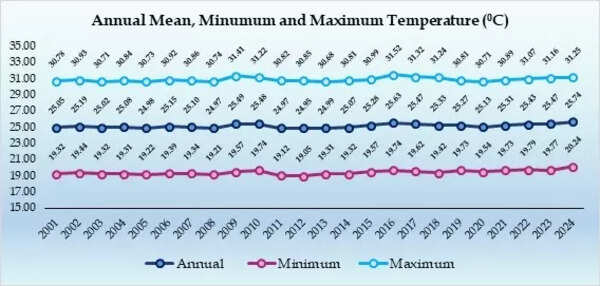India’s annual mean temperature rise up from 25.05°C in 2001 to 25.74°C in 2024, Electricity generation from renewable sources increased more than three times in 10 years | India News

NEW DELHI: Showing a warming trend in sync with the overall global temperature rise, India’s annual mean temperature increased from 25.05°C in 2001 to 25.74°C in 2024, as per a compilation of updated environmental data released by the govt on World Environment Day Thursday.The year 2024 was the hottest in India since nationwide records began in 1901. Even globally, 2024 was the warmest year in the 175 year observational record.

The compilation — EnviStats India 2025: Environment Statistics — showed that the annual minimum (night) and maximum (day) temperature rose from 19.32°C to 20.24°C and from 30.78°C to 31.25°C, respectively, during 2021-24.It also showed that electricity generation from renewable energy sources in the country has increased more than three times in the past 10 years — from 65,520 gigawatt-hour (GWh) to 2,25,835 GWh during 2013-14 to 2023-24 — whereas thermal power generation has increased from 7,92,053 GWh to 13,26,549 GWh during the period.

The data in the publication, released by the ministry of statistics and programme implementation, is compiled based on figures from central ministries and departments.It showed that globally, there are 2,47,605 marine faunal species, which include 20,613 from India. The country has 9,436 freshwater species, 5,023 species in its mangrove system, 3,383 species in estuarine ecosystem, and 22,404 species in its soil ecosystem.As far as the total count of faunal species is concerned, the world has 16,73,627 species of which 1,04,561 are found in India, underscoring the country’s significant contribution to global faunal diversity across different habitats.

Referring to inland fish, the publication shows that its production has increased from 61 lakh tonnes in 2013-14 to 139 lakh tonnes in 2023–24. With a slower growth, marine production, on the other hand, has increased from 34 lakh tonnes to nearly 45 lakh tonnes during the same period.The monthly rainfall data from 2001 to 2024 reveals seasonal variability, with the majority of rainfall occurring between June to September. The monthly fluctuations may suggest shifting rainfall patterns within the monsoon season such as late onsets or prolonged rainfall into October, which may hint at evolving climatic conditions.

According to the compilation, the Environment Sustainability Sector shows the highest expenditure share with Rs 2433 crore in 2021-22 among the three sectors (Agro-Forestry, Conservation of Natural Resources, and Environment Sustainability).The Conservation of Natural Resource Sector shows an upward trend whereas the Agro-Forestry Sector exhibits the lowest expenditure.





